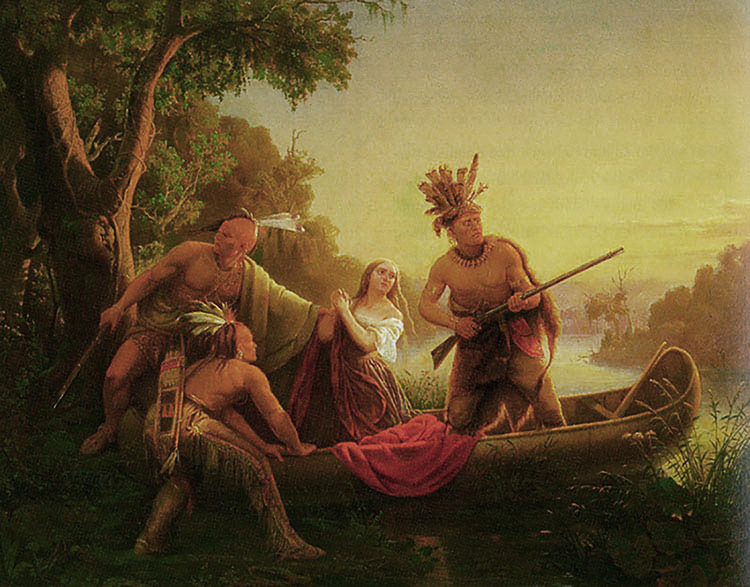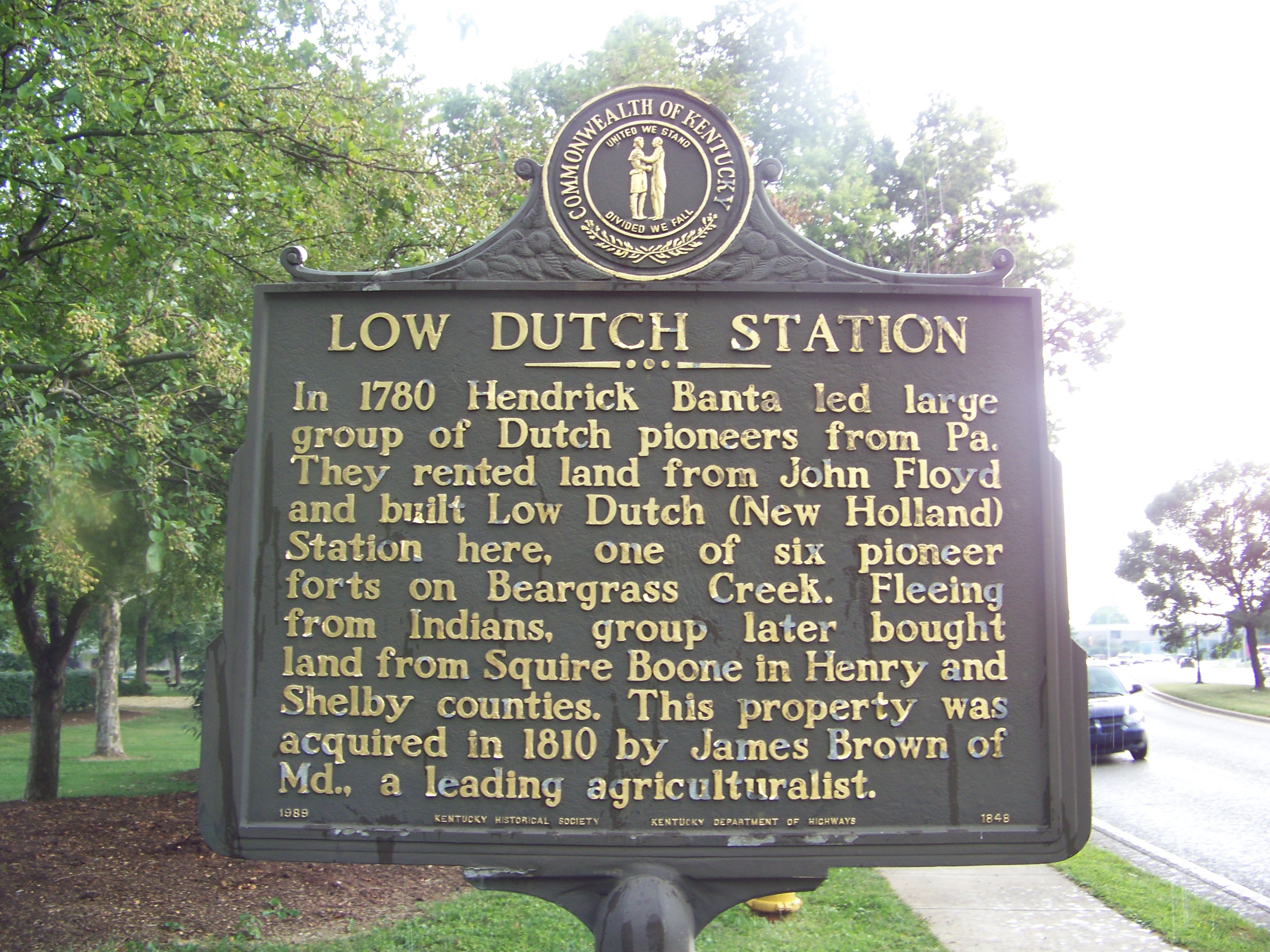|
Floyd's Station
Floyd's Station was a fort on Beargrass Creek in what is now St. Matthews, Kentucky. In November 1779 James John Floyd built cabins and a stockade near what is now Breckenridge Lane. In 1783, John Floyd, future Governor of Virginia was born in the Station. The pioneer's father was killed by Indians twelve days before the birth of his son. The station was one of six on Beargrass Creek and was involved in local conflict with Native Americans in the area for the next five years. All that remain today of Floyd's Station are a spring house and cemetery. Approximate location: Gallery Image:James John Floyd.jpg, James John Floyd Image:John Floyd (cropped).jpg, John Floyd Image:CHARLESFLOYD.jpg, Charles Floyd Image:FLOYDSTATIONAREA.jpg, 2008 Area Scene See also *Corn Island (Kentucky) *Fort Nelson (Kentucky) *Fort-on-Shore *Fort William (Kentucky) *Spring Station (Kentucky) * Low Dutch Station * Bryan's Station *Station (frontier defensive structure) A station was a defensible resi ... [...More Info...] [...Related Items...] OR: [Wikipedia] [Google] [Baidu] |
Beargrass Creek (Kentucky)
Beargrass Creek is the name given to several forks of a creek in Jefferson County, Kentucky. The Beargrass Creek watershed is one of the largest in the county, draining over . It is fairly small, with an average discharge of 103 cubic feet per second at River Road in Louisville. As the forks wind through the area that has become Louisville's East End, they have contributed to the geography that has shaped the area. The origin of the name "Beargrass" is not clear, though local stories abound and it was written as "Baregrass Creek" and "Bear Grass Creek" in early maps. Lyndon Lore states, "The name Beargrass was originally Bear Grasse, because the bears came to the creek for water and also for salt from the salt licks which were located near Salt River." Howeverthis mapof Louisville from 1780 shows the name as Baregrass Creek. The earliest settlements by Europeans in the area were built in the form of stations, or forts, along the banks of the creek. The three forks drain about ... [...More Info...] [...Related Items...] OR: [Wikipedia] [Google] [Baidu] |
James John Floyd
Colonel James John Floyd (1750 – 10 April 1783) was an American military officer. An early settler of St. Matthews, Kentucky, he helped lay out Louisville. In Kentucky, he served as a Colonel of the Kentucky Militia in which he participated in raids with George Rogers Clark and later became one of the first judges of Kentucky. Biography Virginia Floyd was born in 1750 in Amherst County, Virginia, to William and Abadiah (Davis) Floyd,Kleber, John E. ''The Encyclopedia of Louisville'' (University Press of Kentucky), page 300. descendants of Welsh immigrants. Family legend was that his mother was a descendant of the Powhatan chieftain Opchanacanough.Ambler, Charles Henry, ''The Life and Diary of John Floyd'' (Richmond Press), pages 13–30. Another family tradition maintains that her brother was Evan Davis, the grandfather of Jefferson Davis. In Virginia, the Floyd family operated a farm and made a decent living there, but the younger Floyd knew opportunity to do better was i ... [...More Info...] [...Related Items...] OR: [Wikipedia] [Google] [Baidu] |
Stockade
A stockade is an enclosure of palisades and tall walls, made of logs placed side by side vertically, with the tops sharpened as a defensive wall. Etymology ''Stockade'' is derived from the French word ''estocade''. The French word was derived from the Spanish word ''estacada''. As a security fence The troops or settlers would build a stockade by clearing a space of woodland and using the trees whole or chopped in half, with one end sharpened on each. They would dig a narrow trench around the area, and stand the sharpened logs side-by-side inside it, encircling the perimeter. Sometimes they would add additional defence by placing sharpened sticks in a shallow secondary trench outside the stockade. In colder climates sometimes the stockade received a coating of clay or mud that would make the crude wall wind-proof. Builders could also place stones or thick mud layers at the foot of the stockade, improving the resistance of the wall. From that the defenders could, if they had the ... [...More Info...] [...Related Items...] OR: [Wikipedia] [Google] [Baidu] |
Virginia
Virginia, officially the Commonwealth of Virginia, is a U.S. state, state in the Southeastern United States, Southeastern and Mid-Atlantic (United States), Mid-Atlantic regions of the United States between the East Coast of the United States, Atlantic Coast and the Appalachian Mountains. The state's List of capitals in the United States, capital is Richmond, Virginia, Richmond and its most populous city is Virginia Beach, Virginia, Virginia Beach. Its most populous subdivision is Fairfax County, Virginia, Fairfax County, part of Northern Virginia, where slightly over a third of Virginia's population of more than 8.8million live. Eastern Virginia is part of the Atlantic Plain, and the Middle Peninsula forms the mouth of the Chesapeake Bay. Central Virginia lies predominantly in the Piedmont (United States), Piedmont, the foothill region of the Blue Ridge Mountains, which cross the western and southwestern parts of the state. The fertile Shenandoah Valley fosters the state's mo ... [...More Info...] [...Related Items...] OR: [Wikipedia] [Google] [Baidu] |
Corn Island (Kentucky)
Corn Island, formerly Dunmore's Island, was an island in the Ohio River at head of the Falls of the Ohio, just north of Louisville, Kentucky. Estimates of the size of Corn Island, now submerged, vary with time, as it gradually was eroded and became submerged. A 1780 survey listed its size at . It then extended from what is now Louisville's Fourth to Fourteenth Streets. The first settlement that later became Louisville on the mainland was established on the island in 1778 by George Rogers Clark. History Corn Island was first surveyed in 1773 by Virginia Captain Thomas Bullitt's party and called ''Dunmore's Island'' (after John Murray, 4th Earl of Dunmore, Crown Governor of Virginia). Surveying expeditions like that helped to provoke Dunmore's War the following year. During the American Revolutionary War, the island was settled on May 27, 1778, by George Rogers Clark's militia and 60 civilian settlers, who remained behind when Clark's party departed on June 24. Among the surviv ... [...More Info...] [...Related Items...] OR: [Wikipedia] [Google] [Baidu] |
Fort Nelson (Kentucky)
Fort Nelson, built in 1781 by troops under George Rogers Clark including Captain Richard Chenoweth, was the second on-shore fort on the Ohio River in the area of what is now downtown Louisville, downtown Louisville, Kentucky. #Fort-on-Shore, Fort-on-Shore, the downriver and first on-shore fort, had proved to be insufficient barely three years after it was established. In response to continuing attacks from Native Americans in the United States, Native Americans and the threat of Kingdom of Great Britain, British attacks during the American Revolutionary War, Revolutionary War, Fort Nelson was constructed between what is currently Main Street and the river, with its main gate near Seventh Street. It was named after Thomas Nelson Jr., then the governor of Virginia. (Kentucky was part of Virginia at the time.) The fort was used as a courthouse and jail until one was built. The fort was garrisoned until the building of Jeffersonville, Indiana#History, Fort Finney across the river at ... [...More Info...] [...Related Items...] OR: [Wikipedia] [Google] [Baidu] |
Fort-on-Shore
Fort Nelson, built in 1781 by troops under George Rogers Clark including Captain Richard Chenoweth, was the second on-shore fort on the Ohio River in the area of what is now downtown Louisville, Kentucky. Fort-on-Shore, the downriver and first on-shore fort, had proved to be insufficient barely three years after it was established. In response to continuing attacks from Native Americans and the threat of British attacks during the Revolutionary War, Fort Nelson was constructed between what is currently Main Street and the river, with its main gate near Seventh Street. It was named after Thomas Nelson Jr., then the governor of Virginia. (Kentucky was part of Virginia at the time.) The fort was used as a courthouse and jail until one was built. The fort was garrisoned until the building of Fort Finney across the river at the site of what is today Jeffersonville, Indiana about 1784. Ironically, the fort was built late in the Revolutionary War when the need for it had almost dis ... [...More Info...] [...Related Items...] OR: [Wikipedia] [Google] [Baidu] |
Fort William (Kentucky)
Fort William was a pioneer fort in Kentucky established in 1785 by Colonel William Christian and Anne Christian. William Christian directed the defense of what is now Louisville from attacks by the Indians. The fort was in the area of Jefferson County near St. Matthews and Lyndon. Although the historical marker for Fort William is located in front of the Eight Mile House, an early stone house and tavern, the location of the fort was actually southwest of the Eight Mile House. Fort William was another name for A'Sturgus Station built in 1779 on the Middle fork of Beargrass Creek. After Christian's death in 1786, his wife, Anne, began to refer to the site as Fort William. Anne Christian was a sister of Patrick Henry. The land acquired by the Christians was payment for his service during the Seven Years' War. They moved into the area with children and slaves. After William Christian's death, Anne moved to Mercer County. However, she was ill and traveled to the West Indies in hope ... [...More Info...] [...Related Items...] OR: [Wikipedia] [Google] [Baidu] |
Spring Station (Kentucky)
Spring Station, Kentucky is an Unincorporated area#United States, unincorporated community in the northern part of Woodford County, Kentucky located approximately three miles west of Midway, Kentucky, Midway. The area is said to have been settled during the early part of the 19th century and it became a station stop on the Lexington and Ohio Railroad line when it was opened through the village in 1833. According to the University of Kentucky, it "was named for several nearby springs and may also have been known as Big Spring Station." A United States Postal Service, postal outlet operated at Spring Station from year 1856 to 1973. Spring Station was home to the Woodburn Stud, a thoroughbred and standardbred horse breeding operation built by Robert A. Alexander which became the birthplace of Kentucky's Thoroughbred industry. In 1869, Daniel Swigert, who bred three Kentucky Derby winners, built a thoroughbred horse breeding business at Spring Station he named Stockwood Farm. Ref ... [...More Info...] [...Related Items...] OR: [Wikipedia] [Google] [Baidu] |
Low Dutch Station
Low Dutch Station was established in 1780 on the middle fork of Beargrass Creek (Kentucky), Beargrass Creek in Kentucky. This station (frontier defensive structure), station was settled by Dutch (ethnic group), Dutch pioneers from Pennsylvania and was also known as New Holland Station. The station was one of a group of seven forts established on Beargrass Creek during this period in this area that is now a part of Louisville, Kentucky, Louisville. The leader of the group was Hendrick Banta. The group of settlers were a part of the "Low Dutch Company" and had their own bylaws, a formal charter, and accounting procedures. The group had as its purpose the preservation of the language, culture and religion of the Dutch. The Dutch traveled from a settlement near Harrodsburg, Kentucky, Harrodsburg to Low Dutch Station. There is no connection between Low Dutch Station or its settlers and the nearby road known as Dutchmans Lane in St. Matthews, Kentucky, St. Matthews. The aforementioned ... [...More Info...] [...Related Items...] OR: [Wikipedia] [Google] [Baidu] |




